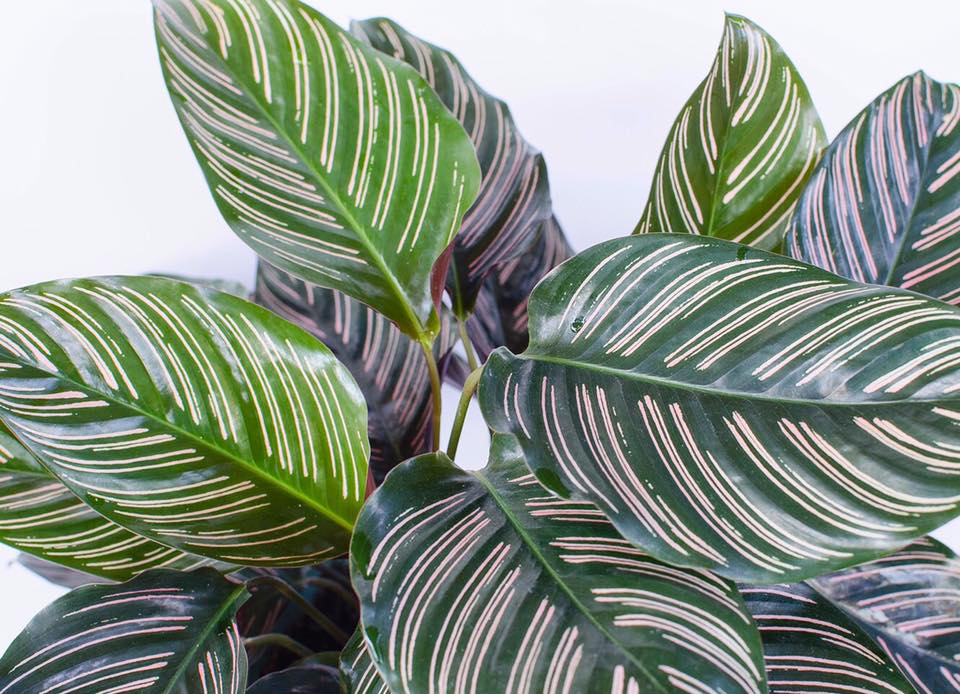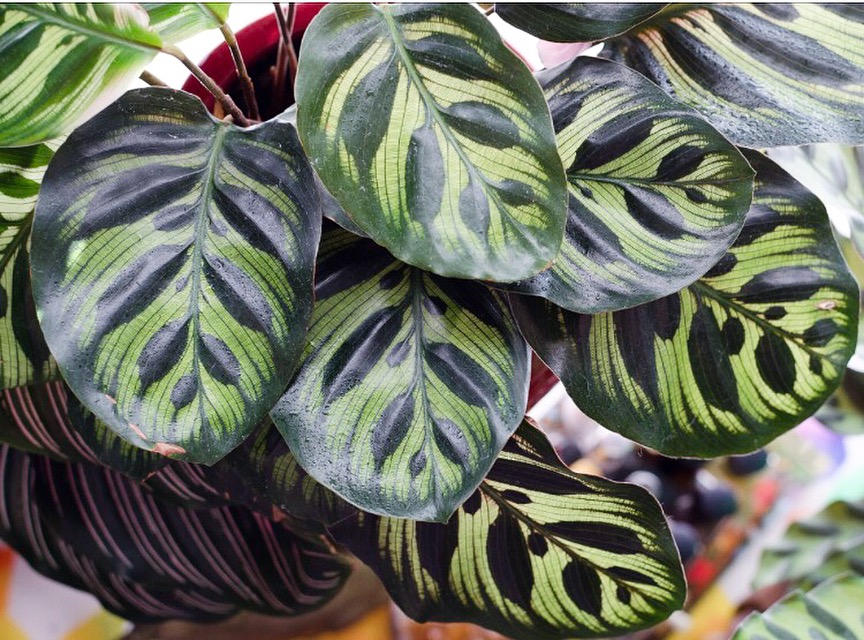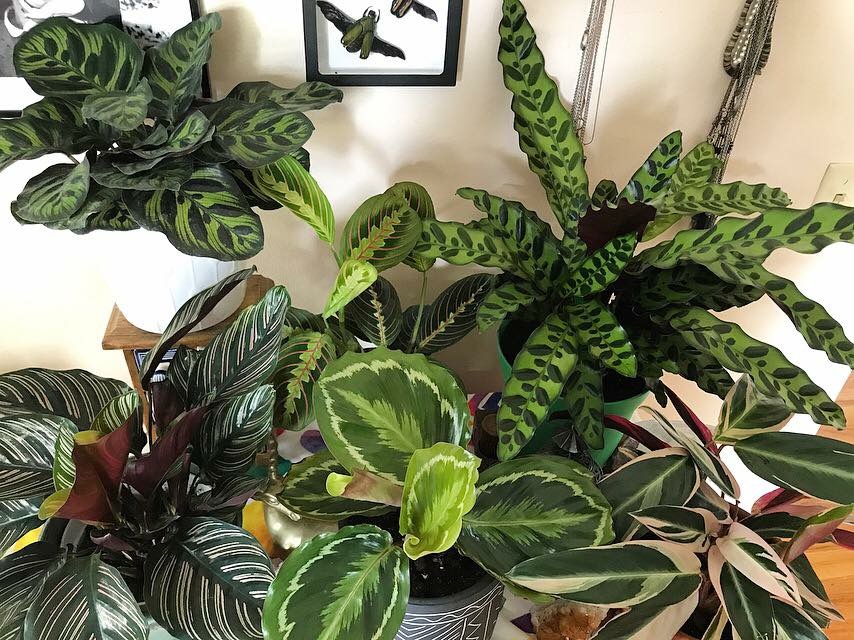Plant profile: Calatheas
Calathea oranata is a popular species of calathea that is readily available in many local nurseries.
If you've successfully managed to keep some low to moderate-maintenance plants alive and want a bit of a challenge, plants from the Calathea genus are a good next step: more difficult than a sturdy pothos, but still easier than diva-like orchids or ferns. Calathea species are something of a specialty of mine, and I've taken it upon myself to collect as many varieties as possible and to learn as much about them as my brain will allow. The reason I've had great success with them is by making sure their very particular demands are met.
Calatheas are known for their striking patterned foliage, with the undersides of their leaves often being tinged with purplish-red hues. The leaves come in many different shapes, sizes, and patterns, but most won't grow larger than about 3 feet. There are many species, but I'm going to focus on the genus as a whole, since all of it's species have similar care needs.
Fun facts: Calatheas are part of the Marantaceae family, which includes maranta, stromanthe, and ctenanthe species. Stromanthes and ctenanthes are less common, but you can find the popular Maranta leuconeura (or prayer plant as they're commonly known) at just about any big box garden center. Just like the maranta prayer plant, a calatheas' leaves fold up at night as if they were hand in prayer - it also allows the plants to show off their colorful undersides!
Lighting: Calatheas are often labeled as a "low light" plant, but if you've read my post on lighting, you know that most low light plants actually thrive in bright, filtered light as long as there's not direct sun falling on their leaves. That said, calatheas will do well in front of a north-facing window, but even better in front of an east or west-facing window that has blinds or sheer curtains. Experiment with the lighting. If your calathea's leaves start cupping inwards, it's getting too much light. Too much light can also cause fading of their beautiful markings, or even worse, sun burn.
Watering: Watering a calathea can be a bit of a learning curve since they like to be consistently moist, but not soggy. They have small, delicate root systems, so you don't want to water too much as to drown their tender roots. If you're new to calatheas, don't feel bad if you lose a lot of bottom leaves to yellowing due to overwatering! You just have to find that sweet spot. Start with watering when the top half inch or so of soil is dry, and give it little sips of water. You don't need to drench the soil so much that there's a lot of water draining through the bottom of the pot. Make sure your calathea is in a container with holes as well, as it absolutely can't stand to sit in water.
Another important aspect of watering these kinds of plants is using the right kind of water. Most houseplants are fine with tap water, but calatheas are sensitive to the salts, fluoride, and other chemicals in tap water. Some folks say they water their calatheas with tap and never have a problem, but they probably don't have hard water! Most city water is pretty hard in my experience. I believe it's better to be safe than sorry with these delicate beauties and use distilled or rain water. If you don't have access to either, fill a jug with tap water and let it sit out for 24-48 hours before using it. You'll know if you have a hard water problem because the edges and tips of the leaves will have a yellowish-brown burned look to them.
Humidity + temperature: Calatheas are native to South American tropics, and are famous for needing very high humidity and warm temperatures that mimic their homeland. They might be thriving at the greenhouse, but throw a fit at your house if the air it too dry, or if it's next to an AC vent. Make sure the temperature is between 65-90 degrees Fahrenheit, and give it constant humidity of 60% or above. Calatheas do well when grouped together with other plants in order to create a greenhouse effect, and benefit from pebble trays, or better yet: humidifiers. You can mist to keep the leaves looking clean and free of dust, but misting doesn't cut it for these plants in terms of humidity. A humidifier will allow for the constant, high humidity that a calathea needs. If you have a terrarium container large enough, calatheas are the PERFECT candidate for terrariums since they're true greenhouse plants. They'll also relish the humidity outside in summer months as long as they're in bright shade.
Soil + fertilizer: I mentioned earlier that calatheas don't like their roots to stay too wet, but at the same time, are sensitive to drying out. Use a potting medium that's well-draining, but also holds onto moisture. An organic potting mix with peat moss and perlite is best.
Fertilize with a liquid plant food high in nitrogen (10-20-10 is the number to look for on the package) every month or so, or even every three weeks if growth is very fast. It's best to under-fertilize than over-fertilize with calatheas, in my experience, because over-fertilizing can cause leaf burn.
Repotting: Repot every spring into a container with drainage holes. Whether you use terra cotta or plastic is up to you, but I find that my calatheas enjoy plastic containers more since they like their soil to be moist at all times. Terra cotta pots can be too drying for some plants.
Common problems:
- Leaf burn - usually caused by tap water or over-fertilizing.
- Brown shriveled tips or browning edges - not enough humidity.
- Dry, dark brown tips - the soil stays dry for too long.
- Mealybugs and spider mites - calatheas seem to be susceptible to these pests the most, usually if the soil is too dry.
- Fungal and bacterial diseases - these usually crop up when there is too much humidity, but you likely won't have that problem unless you keep your calatheas in a very moist greenhouse.
Popular species (my no means an extensive list, just a few favorites):
Calathea lancifola (rattlesnake plant) - elongated, sword-like leaves with dark green patterning on a bright green background.
C. roseopicta (medallion plant) - oval-ish leaves with feathery pink or white markings and dark purple-red undersides.
C. makoyana (peacock plant or cathedral window plant) - papery thin leaves with fine markings like pen etchings. The leaves are opaque, so if you hold a leaf in front of a window, you can see light!
C. oranata (pinstripe plant) - elongated oval leaves with "pinstripe" markings, hence the name. Markings usually start out pink and fade to white.
Clockwise from bottom right: C. ornata, C. mayonaka, Maranta leuconeura, C. lancifola, Stromanthe sanguinea, C. roseopicta.



